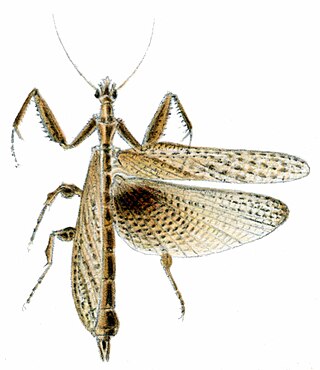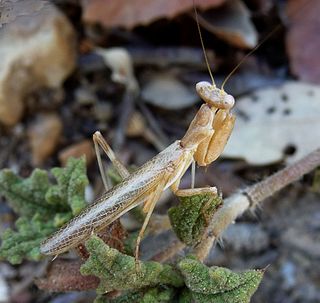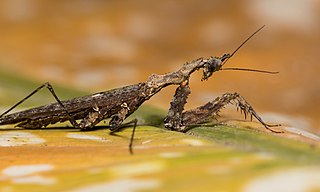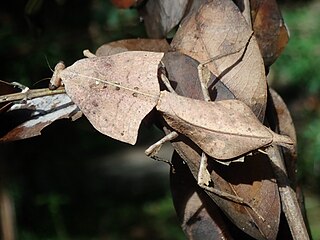
Metallyticus is a genus of praying mantis. It is the only genus in the monotypic family Metallyticidae. They are mostly found in South-East Asia. The species of the genus are dark, somewhat flattened and cockroach-like, and often with a cuticle that is reflective and metallic in appearance.

Metallyticus splendidus is a rare species of praying mantis found in Southeast Asia. It has an iridescent appearance.

Rhombodera is a genus of praying mantises native to Asia and possessing common names such as shield mantis, hood mantis, and leaf mantis because of their extended, leaf-like thoraxes.

Acanthopidae is a family of South American mantises consisting of 16 genera in the order Mantodea. The group was first formally split off as a separate family by the German entomologist Reinhard Ehrmann in 2002. In 2016, five genera were moved from Acanthopidae to the newly created family Acontistidae, but this has not been accepted in most recent classifications.

Stenophylla is a genus of praying mantis in the subfamily Stenophyllinae, which is now placed in the family Acanthopidae. It the sole genus of the tribe Stenophyllini.
Charieis is a genus of mantids in the family Tarachodidae. It is a monotypic genus with a single recognised species, Charieis peeli.

Galinthiadidae is a family of 24 African mantis species in four genera.

The mantis family Amelidae was previously placed in the family Mantidae. Species have been recorded from Africa, Asia, Europe and North America.

Iridopteryginae is a subfamily of mantises in the family Gonypetidae. There are two tribes, distributed in tropical Asia.

Tropidomantinae is a subfamily of mantises in the new (2019) family Nanomantidae. Within the single tribe Tropidomantini there are six genera, distributed in Asia and the Pacific.

Acontistini is a tribe of neotropical mantises in the superfamily Acanthopoidea, and family Acanthopidae. There are 7 genera and more than 30 described species in Acontistini. In 2016, several genera were moved from Acanthopidae to a newly created family Acontistidae, but this has not been accepted in most recent classifications.

Coptopterygidae is a family of mantises in the order Mantodea. There are at least 2 genera and more than 20 described species in Coptopterygidae.

Photinaidae is a family of mantises in the order Neotropical Mantodea, in the superfamily Acanthopoidea. There are about 11 genera and more than 40 described species in Photinaidae.
Thespinae is a subfamily of mantises in the family Thespidae. There are 16 genera and at least 40 described species: found in most continents.

Haaniinae is a subfamily of mantises, now placed in the new (2019) family Haaniidae; the species can be found in Asia.
Nanomantini is a tribe of Asian mantises in the new (2019) family Nanomantidae. There are about 6 genera and 10 described species in Nanomantini.
Rhombomantis is a genus of mantids in the family Mantidae. There are at least four described species in Rhombomantis.

Pseudovates is a genus of praying mantis in the family Mantidae. There are more than 20 described species in the genus Pseudovates, and are found in North, Central, and South America.

The Deroplatyidae are a new (2019) family of praying mantises, based on the type genus Deroplatys. As part of a major revision of mantis taxonomy, the subfamily Deroplatyinae has been moved here from the previously structured family Mantidae.

The Rivetinidae are a family of praying mantids, based on the type genus Rivetina. As part of a major revision of mantid taxonomy, this family contains many genera moved from Miomantinae: tribe Rivetinini; some genera previously placed there have now been moved to the new families Deroplatyidae and Chroicopteridae. The new placement of this taxon is in the superfamily Eremiaphiloidea and infraorder Schizomantodea.















